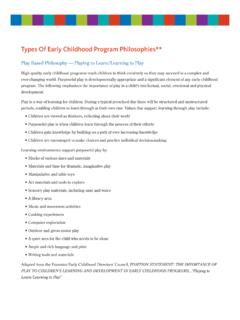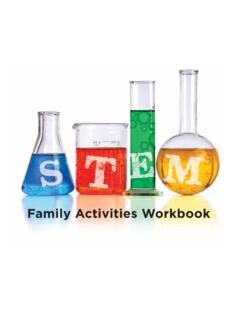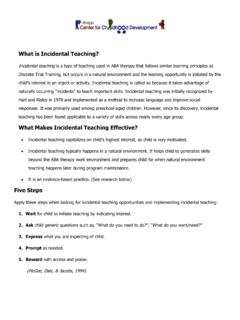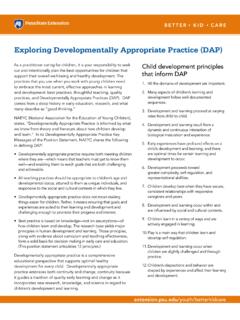Transcription of TEACHING PRESCHOOLERS ABOUT MEASURING LENGTH
1 When we measure LENGTH we apply a predetermined unit to an object so that we can to see how long, or wide, or tall it is ( , inches, meters). For example, we might use a ruler to measure the LENGTH of a table. Three- and four-year-old children typically know how to compare the LENGTH of things by looking at them side-by-side. However, they typically do not understand how to measure them using a unit. Their competencies grow over time as teachers model MEASURING using a third object or unit for comparing the lengths of two or more things ( , a block, a ruler, a thumb). Their under-standing of the how and why of measurement also grows as teachers use measurement language to mathematize naturally occurring, everyday experiences ( , Wow! That playdough snake must be 8 inches long! It s longer than my fingers!)
2 I wonder if this new book will be too tall for our bookshelf. Let s measure it! ). Providing standard MEASURING tools ( , ruler, tape measure) in the classroom environment helps familiarize children with them and encourages children to engage in measurement play. While many teachers begin exposing children to units of measurement using nonstan-dard units ( , a hand, a block, a floor tile), research shows that frequent switching back and forth between several dif-ferent nonstandard units of measurement may be confusing to young children until they develop a basic understanding of measurement. Therefore, it is preferable to begin with a standard unit, such as a ruler (Clements & Sarama, 2014). PRESCHOOLERS Competencies at MEASURING LengthLength is an aspect of measurement that is appealing to preoperational learners.
3 They rely on their visual percep-tion and are often interested in determining which of two objects is longer, shorter, or wider than the other. They can sequence objects by LENGTH when they align the edges of the objects. For example, objects can be aligned to measure height by standing them side-by side on a table or the floor, or, in the case of width, by pushing both objects up against a wall. However, children are not truly able to conceptualize and measure LENGTH accurately until they reach the stage of concrete operations at around age 8. Measurement is a difficult skill, but also involves many concepts (Clements & Sarama, 2014, p. 187). Preoperational learners have not mastered the developmental concepts of conservation and transivity described by Piaget. When a child can conserve, she understands that prop-erties and amounts stay the same even when physical appearances are changed (Trawick-Smith, 2014).
4 Imag-ine two sticks that are equal in LENGTH and positioned with their ends lined up evenly. Children who cannot conserve believe that one stick is longer than the other if it is moved forward. Children who can conserve understand that the LENGTH of the sticks remains equal, even when the sticks are placed in different positions. Measurement also involves transitive inferences. A child must understand transivity before she can use a third object such as a ruler or a piece of string to measure two objects. This means that a child understands that if A = B (the measure) and B = C, then A and C are equivalent (National Research Council, 2009). In the classroom A might be a toy railroad track the child wishes to measure. B might be a piece of yarn the child has used to measure the railroad track, A.
5 The child can then use the same piece of yarn to see if a second piece of railroad track, C, is the same LENGTH as railroad tie TEACHING PRESCHOOLERS ABOUT MEASURING LENGTHBy Sallee BenekeTable 1. Steps/Ages in Learning to Think ABOUT Linear Measurement*Steps/AgesSkillRelated CompetenciesSTEP 1: Beginning Two & Three Year Thinking visually/holisticallyInformally recognizes LENGTH as an extention of 1-D space. Compare 2 objects directly, noting equality or 2: Four Year Thinking ABOUT partsCompares the LENGTH of two objects by representing them with a third object. Initially measures by laying units end to Relating parts and wholesSeriates up to six objects by LENGTH ( , connecting cube towers).*Adapted from National Research Council (2009) A. The piece of yarn in this example is a nonstandard unit of measure.
6 While children enjoy MEASURING with nonstandard units of measure, they are more successful MEASURING with standard tools for measurement ( , rulers, Unifix cubes) than they are with nonstandard units (National Research Council, 2009).Accurate measurement also involves unitizing. This means that the child perceives the finite LENGTH of the object to be measured and can visualize MEASURING it using a repeated unit of measurement such as a ruler or Unifix cube they can mentally picture the object to be measured as divided into units of equal LENGTH . Children are typically not able to unitize before age 8. Develop-ing the ability to measure units without leaving gaps between the units or overlapping them is an important task for young children who are beginning to learning to measure mastering the concepts of conservation, transiv-ity, and unitizing make measurement easier, young children are able to begin to learn the idea of measure-ment (Sarama & Clements, 2014), as seen through the examples provided in Table for Helping PRESCHOOLERS Learn ABOUT MEASURING LengthEngaging young children in the following five math-ematical processes helps them develop and commu-nicate their thinking ABOUT all areas of mathematics, including measurement (National Council of Teachers of Mathematics, 2000).
7 These mathematical processes are: (a) representing, (b) problem solving, (c) reason-ing and proof, (d) connecting, and (e) communicating. Educators can teach children to use these five processes to mathematize or relate measurement concepts to their everyday world. Tables 2 and 3 provide examples of language and materials that teachers can employ to help PRESCHOOLERS use these Children may represent their under-standing of MEASURING LENGTH in a variety of ways. For example, drawing pictures of objects that are the same or different lengths. As children develop a basic under-standing of math concepts, encourage children to select nonstandard objects and use them to measure ( , unit blocks, LEGOS , hands). As they become more compe-tent at MEASURING LENGTH , children can be encouraged to make their own solving.
8 Problem solving and reasoning are the heart of mathematics (NAEYC, 2010). young chil-dren learn by engaging with and solving meaningful problems in their everyday environments. A major way young children begin to learn to measure LENGTH is by comparing. Teachers can encourage children to learn to measure by challenging them to solve problems of comparison ( , Is one longer, shorter, or are they the same? ). Teachers can challenge children to compare LENGTH by lining up the ends of 2 objects. Or children can be challenged to measure objects in the environment using a standard unit of measurement, such as ruler, beginning with zero. Inviting children to measure and Engaging young children in five important mathematical processes helps them develop and communicate their thinking ABOUT all areas of mathematics, including geometrythen re-measure to see if their measurement is accu-rate.
9 This process can help them identify strategies that assist them in MEASURING more and proof. Teachers can challenge preschool children s reasoning by conversing with them ABOUT their efforts to measure the LENGTH of objects and by asking them to explain the decisions they make as they work with units of measurement ( , How do you know where to put the ruler? Why do you start with the end of the ruler lined up with the car you are MEASURING ? ). Asking children to explain their rules for MEASURING accurately also can be help them begin to solidify their thinking ABOUT MEASURING LENGTH . Connecting. At the preschool level teachers can help chil-dren see the relationship of learning to measure and their everyday world. They also can take advantage of naturally occurring opportunities to explore the usefulness of being able to measure LENGTH .
10 For example, when the teacher needs to make a new card for the job chart she might say, Hey, let s measure one of the other cards, so we can make the new one the same LENGTH . Teachers can help focus children s attention on the relationship of number to LENGTH . For example, while MEASURING the LENGTH of the new card for the job chart, the teacher might count out loud, emphasizing that the card is eight inches Encouraging children to communicate their thinking by verbalizing, drawing, writing, gestur-ing, and using concrete objects or symbols can help them share their ideas ABOUT MEASURING LENGTH with other children and adults. As children learn vocabulary related to MEASURING LENGTH they are better able to communicate ABOUT it ( , shorter, longer, same, taller ). Teachers can encourage children to demon-strate and explain how they measure ( , marking the place of the end of the ruler with a finger and then start-ing from exactly that point when MEASURING the next unit) to assess their knowledge, and push them further in their thinking.






